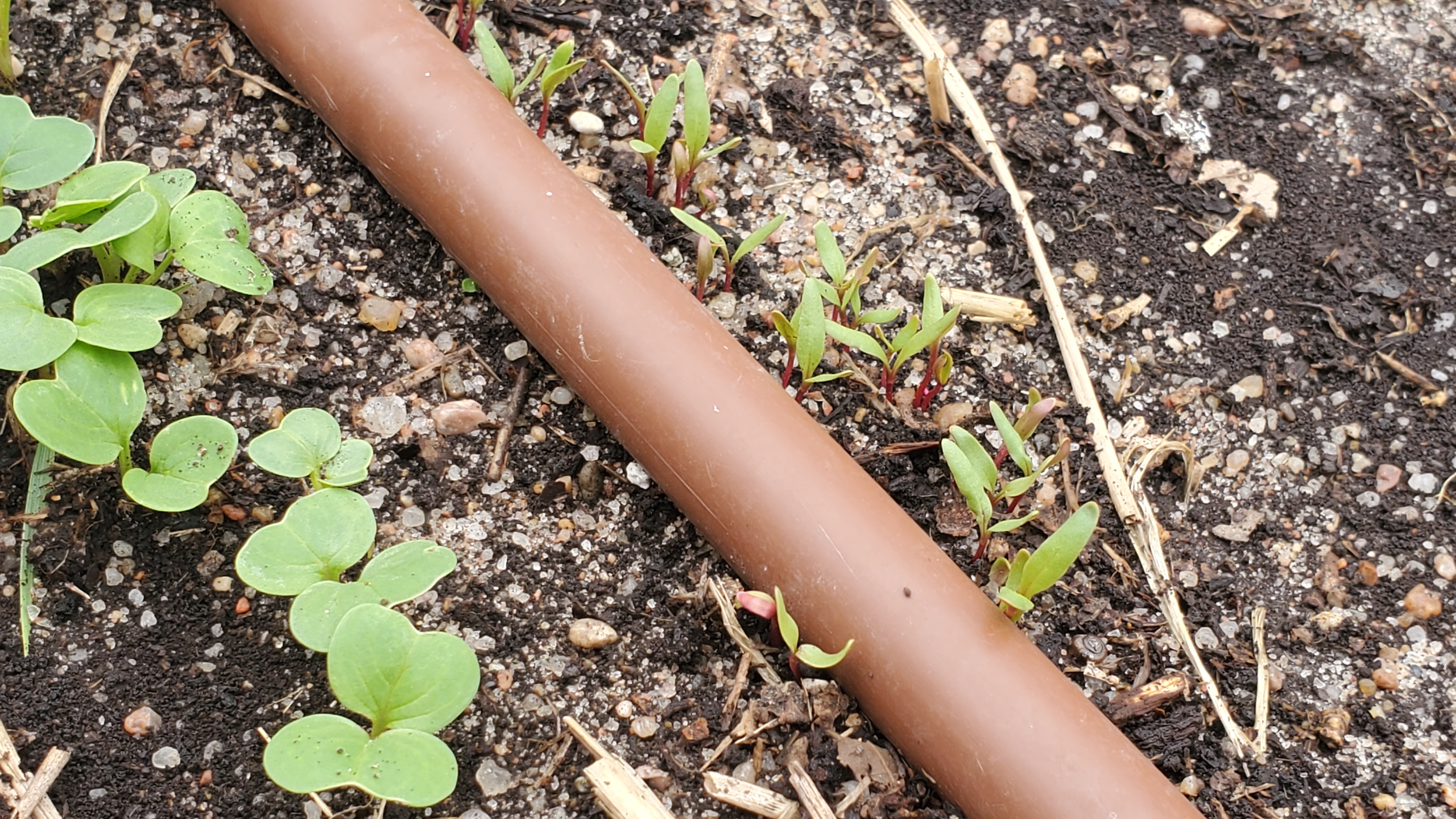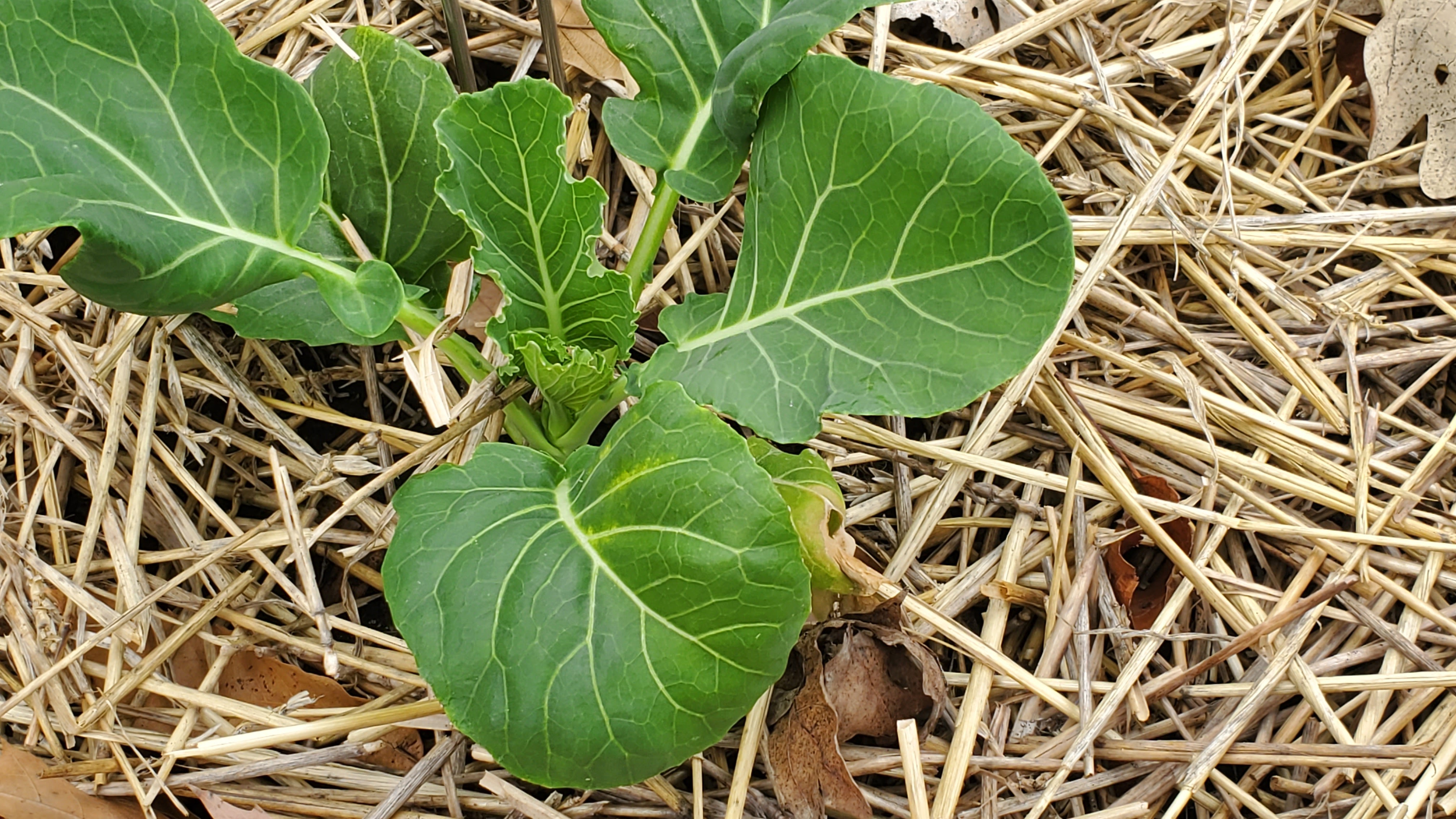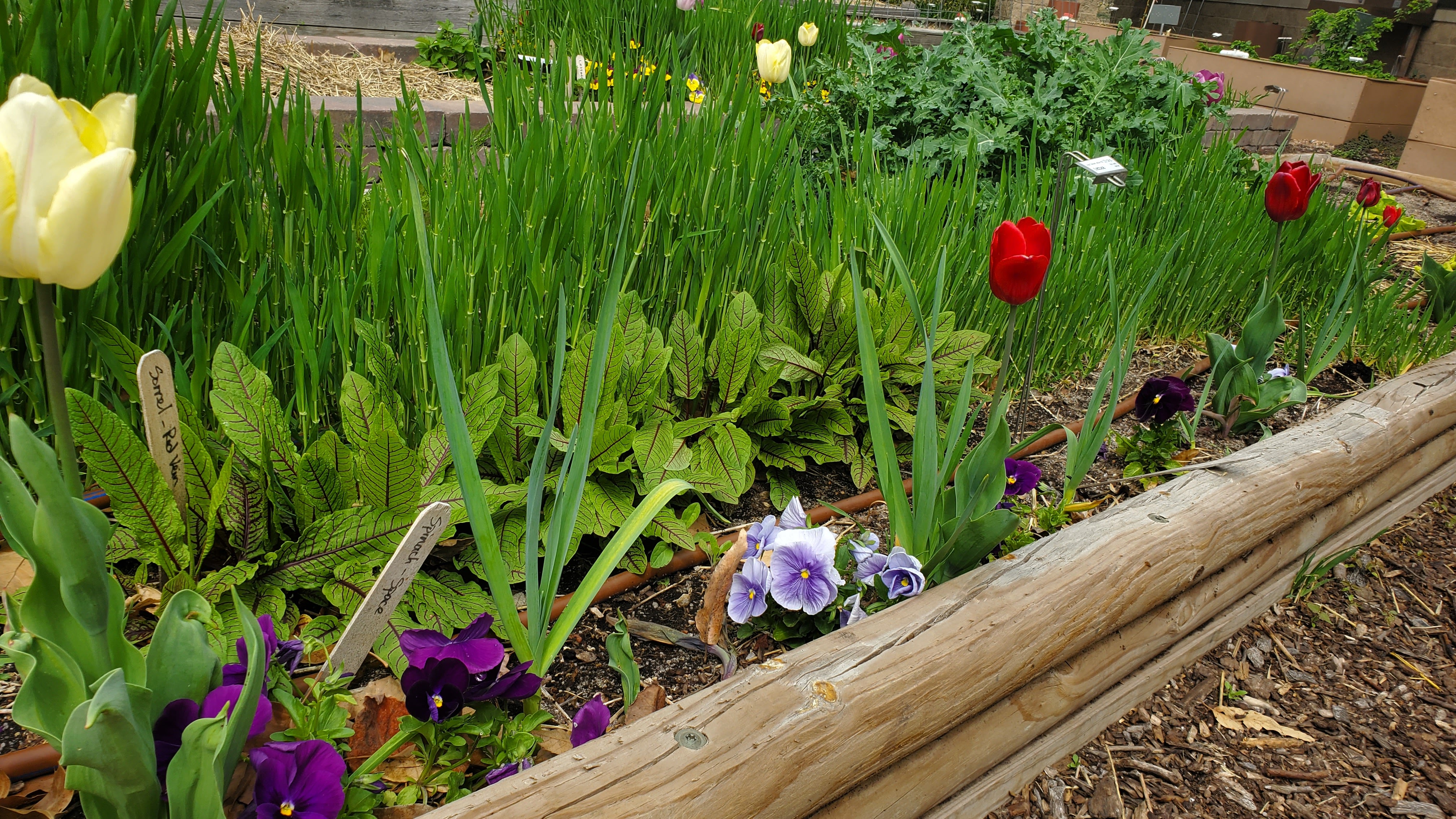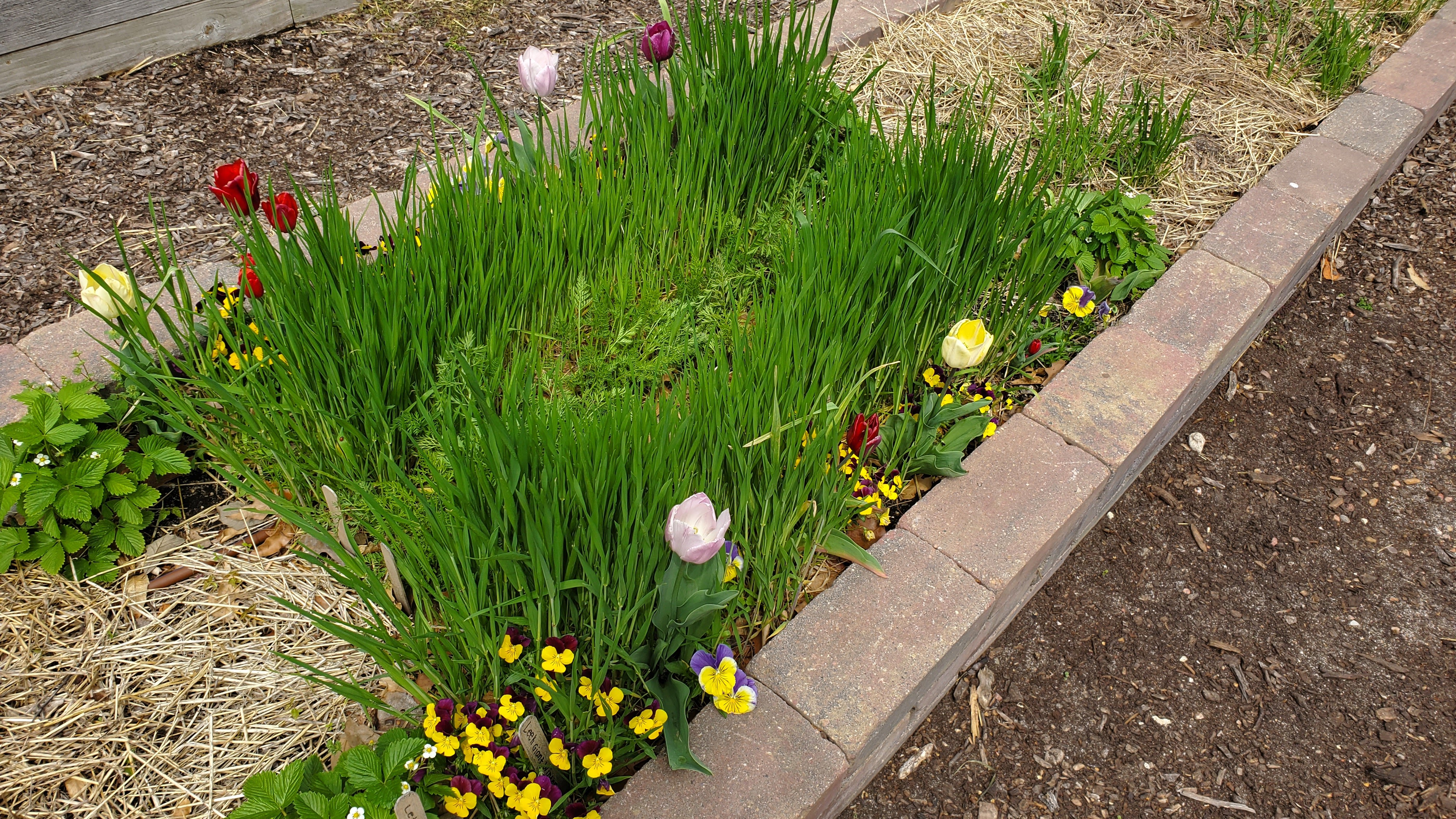Category Archives: Working in the Garden
A Closer Look: Bed 4 Plans
We have made it all the way to our Bed 4 plans for this week’s closer look. Bed 4 is the raised bed where we are planting our Milpa Cover Crop blend of seed. We are working with the Sedgwick County Conservation District, and using the seed from Green Cover Seed.
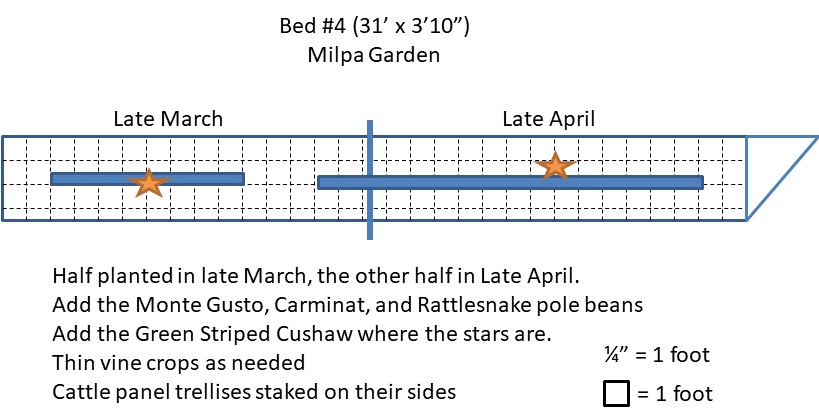
Because we are planting in a raised bed, we can’t quite let it go full on “chaos garden” like if we were planting in a larger field or garden space. The biggest changes we are making are to thin out the vine crops once they germinate to make sure that the bed isn’t overloaded with more than the space can handle. We are also using our cattle panel trellises – on their sides – to provide a little bit more vertical growing space. We will also be adding some pole beans and the Green Striped Cushaw to our planting area. The pole beans are leftover seed from last year. The cushaw we have grown before (it makes amazing pumpkin pie!), and it is highly resistant to squash vine borer.

We also planted the first half of the milpa mix last week, since a number of the things growing are cool season plants. We may have to go back in and plug in some of the warm season things if we don’t get any germination. It has definitely been colder than it sometimes is at this point in the year!

2021 Demo Garden Plans and Updates
Our Demo Garden plantings are well underway for this year, and we already have some exciting things to showcase. But first – here’s a quick overview of what we are planning to grow this year!

We chose to continue to focus our garden efforts on productivity and yield over diversity for this year. We are planning to continue donating our harvests to the Common Ground Producers & Growers Mobile Market for their Seniors First food box program, which provides free food boxes to low income seniors.
With that in mind, we are keeping each garden bed to only a couple different types of produce, although we still have more diversity of varieties than you might otherwise see. We are also focusing on interplanting and succession planting to use our space well. For example, in bed 1, we have radishes planted between rows of beets and carrots and IN the row with the parsnips to use every square inch of space. In Bed 2, we are filling the space with lettuce and spinach now, and then the peppers for the remainder of the season will be planted into the leafy greens while they finish their spring season. In Beds 4 and 5, we have planted broccoli, cauliflower, and peas under the trellises that will hold the cucumbers and squash later in the summer to get an additional crop out of those spaces.
The Master Gardeners have been hard at work getting the garden into shape for the spring, and almost all the beds have either seeds or transplants already growing. We had covered most of the beds with straw last fall, so that is both good and bad now – the soil stays moist with the straw, but we have lots of wheat seedlings growing. We also needed to move quite a bit of the straw around to facilitate seed planting.
The other thing I’m excited to show off a little bit are a couple of the school garden templates that I developed last year and planted last fall.
The templates are 4×8 layouts designed with high diversity (and relatively low productivity) for better interest and learning experiences in a school garden setting. (You can see all the templates and supporting information here: Kansas School Garden Guide.) Both of the templates shown here were designed to be planted last fall and overwintered. These overwintered with NO additional protection from the elements. They include pansies, tulips, garlic, shallots, alpine strawberries, barley or wheat, and vegetables (kale, carrots, red-veined sorrel, spinach).
If you haven’t been out in awhile, our garden is always open to the public – best viewed during daylight hours! Things will be changing fast as it gets warmer, so don’t miss out on the opportunity to visit.
Updated Garden Plans!
 It has been quite the ride since I posted our first look at garden plans for this year, hasn’t it? So many things have changed, and likely many others will before it is all said and done. Because our face-to-face programming is suspended for the time being, we have been thinking about how to adjust our garden for the summer to accommodate the safety of our staff, volunteers, and the public. At the same time, we know that many new gardeners are seeking information on how to start and maintain a successful vegetable garden, and that access to fresh, healthy food is more important now than ever. (And it has always been important!)
It has been quite the ride since I posted our first look at garden plans for this year, hasn’t it? So many things have changed, and likely many others will before it is all said and done. Because our face-to-face programming is suspended for the time being, we have been thinking about how to adjust our garden for the summer to accommodate the safety of our staff, volunteers, and the public. At the same time, we know that many new gardeners are seeking information on how to start and maintain a successful vegetable garden, and that access to fresh, healthy food is more important now than ever. (And it has always been important!)
Because most of our early spring planting was eliminated, with the exception of plants that we already had ready to go, we have re-planned chunks of the garden to change those plans. We also had several parts of the garden that were planned to be more novelties, ornamental, or trials of things that we didn’t know quite how they were going to perform. In order to best fulfill our educational mission and serve our broader community, we have eliminated the majority of those types of plantings from the garden, and will instead replace them with the following:
- Extra tomato and pepper plants that we had started already.
- Beans, squash, and other common, generally productive vegetables that we had available.
- Additional plantings of varieties we have grown in the past, had leftover seed in stock, and knew were going to be productive to replace trial varieties that were less likely to perform well.
Some of the things that we have maintained include:
- Planting the square beds (8, 9, and 10) to perennial fruit plants. If you look at the pic above, you can see the dwarf apple in the front and the blackberries and raspberries growing in bed 9.
- Vertical gardening / trellises to grow lots of cucumbers, melons, and other things throughout the garden.
- The tomato trials of recent All America Selections winners.
- Lots of different colors of veggies!
An additional change, along with planting varieties that emphasize productivity, is that we will be donating significantly more of the produce to those in need. Most years, a large portion of our produce is used for educational programming – for our Master Gardeners or others in the community, and extra produce has been donated. This year the primary focus of our garden will be to donate to those in need as a food bank garden.
As always, we look forward to growing and learning along with you! You might also be interested in joining our new, Victory Garden 101 Facebook Group to engage in more conversations and learning about vegetable gardening. What changes have you made to your garden plans due to the pandemic?
SNAP-Ed Garden Update
Last week we had our first harvest of red saladbowl lettuce, spinach, and radishes, and finished off the harvest this week. We also planted some transplants including a variety of peppers, tomatoes, parsley, and basil; as well as seeds including green beans, zucchini, and cantaloupe.


The green beans have sprouted, the tomatoes and peppers are growing bigger. We also experimented with branches, and made our own tomato cage!

We made a tomato cage out of branches to show how inexpensive gardening can be if you were to reuse items that are commonly on hand, such as tree branches, tied with some twine at the top.
Like I said, in the past two weeks, we were able to harvest red saladbowl lettuce, spinach, and radishes. We took this harvest, weighed each item, and compared them to grocery store prices. Below is how much you would be paying at the grocery store for how much produce we’ve grown so far:
Radishes – 87 total – worth $23.09 at the grocery store
Spinach – 1 lb 4.8 oz – worth $3.13 at the grocery store
Red Salad Bowl Lettuce – 1 lb 7.5 oz – worth $14.10 at the grocery store
Year to Date: $40.32
One of our SNAP-Ed Nutrition Educators was able to use the spinach and red salad bowl lettuce tossed with the radishes and some added carrots for a tossed salad in one of her SNAP-Ed classes at Inter-Faith Ministries!
FINALLY, Spring.
There’s no question about it, spring was reluctant to come and stay this year. While we have tried to stay on schedule with our planting, we ended up delaying a few things until it got a bit warmer. Thankfully, the warm weather coincided with tomato planting time, so we are pretty much back on track!
 This is the garden in mid-April. You can see from the wooden stakes that things had been planted…but not much green was showing up!
This is the garden in mid-April. You can see from the wooden stakes that things had been planted…but not much green was showing up!
 Jumping ahead three weeks to today…there’s a lot more green to be seen, and you can also see that we have been adding trellises and tomato cages!
Jumping ahead three weeks to today…there’s a lot more green to be seen, and you can also see that we have been adding trellises and tomato cages!
 Of our early spring planting, these plants are probably the most spectacular right now. These Chinese cabbages were transplanted the third week of March and have survived multiple nights below freezing with NO protection, snow, cold rain, and wind. The light green is ‘Tokyo Bekana,’ a loose leaf cabbage. The red and dark green are both heading types of Chinese cabbages that are just barely starting to form their heads.
Of our early spring planting, these plants are probably the most spectacular right now. These Chinese cabbages were transplanted the third week of March and have survived multiple nights below freezing with NO protection, snow, cold rain, and wind. The light green is ‘Tokyo Bekana,’ a loose leaf cabbage. The red and dark green are both heading types of Chinese cabbages that are just barely starting to form their heads.
 Also beginning to look good is our SNAP-Ed garden. The radishes, spinach, and lettuce are all finally growing well, and we inter-planted the peppers, tomatoes, and herbs this week. Look for more about this garden to come next week!
Also beginning to look good is our SNAP-Ed garden. The radishes, spinach, and lettuce are all finally growing well, and we inter-planted the peppers, tomatoes, and herbs this week. Look for more about this garden to come next week!
 Of the lettuces we have in the garden this spring, this one is by far the most interesting. This is a variety called ‘Italienischer.’ It is very upright and dark green. At maturity it is supposed to be 18″ tall and heat tolerant. It also has the unique oakleaf leaf shape. It almost looks like an overzealous dandelion!
Of the lettuces we have in the garden this spring, this one is by far the most interesting. This is a variety called ‘Italienischer.’ It is very upright and dark green. At maturity it is supposed to be 18″ tall and heat tolerant. It also has the unique oakleaf leaf shape. It almost looks like an overzealous dandelion!
 While not as beautiful, I also had to share this heirloom lettuce variety – mostly because of the name! The lightly red-tinged leaf lettuce has the name ‘Drunken Woman Frizzy Headed.” I don’t know who came up with that, but…it’s quite the name.
While not as beautiful, I also had to share this heirloom lettuce variety – mostly because of the name! The lightly red-tinged leaf lettuce has the name ‘Drunken Woman Frizzy Headed.” I don’t know who came up with that, but…it’s quite the name.
In addition to tomatoes, we planted most of our herbs (except the basil) and all of the various beans this week. Next week we hope to get the peppers planted as well as the cucumbers, squash, and melons.
Hope to see you at Herb Day tomorrow!


